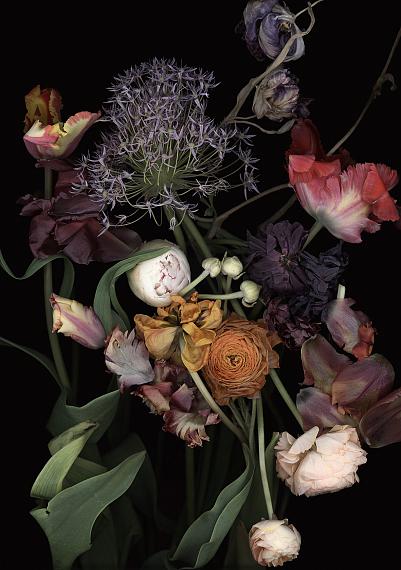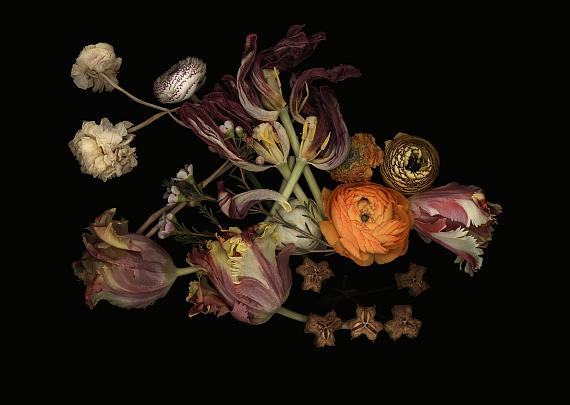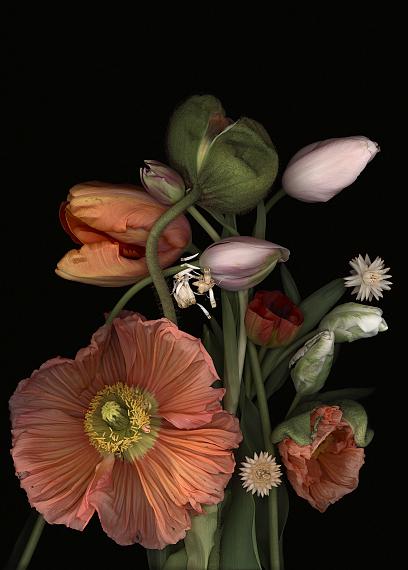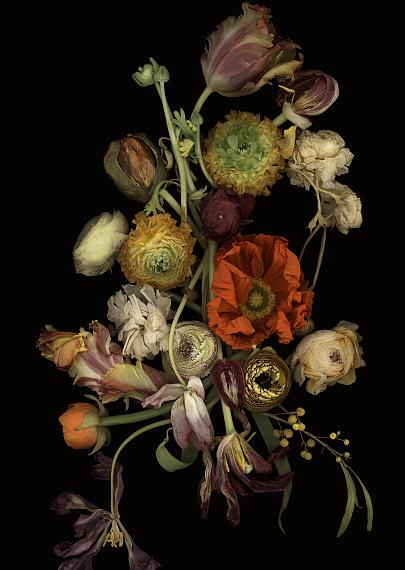
Stockage 179, 2019
Scannogramm
Digital Pigment Print / Hahnemühle Paper
177 x 122 cm / 181 x 126 cm
Edition: 5 + 1AP
Luzia Simons »
Stockage
Exhibition: 12 Nov – 19 Dec 2020
Thu 12 Nov 19:00

Galerie Andreas Binder
Knöbelstr. 27
80538 München
089-21939250
info@galerieandreasbinder.de
www.galerieandreasbinder.de
Tue-Fri 12-18, Sat 11-15

Stockage 187, 2020
Scannogramm
Lightjet Print / Aludibond
142 x 200 cm
Edition: 6
Luzia Simons
"Stockage"
Exhibition: 13 November, 2020 – 30 January, 2021
Opening days:
Thursday, 12 November, 12 – 21 h
Friday, 13 November, 12 – 18 h
Saturday, 14 November, 12 ‐ 17 h
"Stockage" is the first solo exhibiton by the artist Luzia Simons at Andreas Binder Gallery.
The title of the exhibition (engl.: storage) already clarifies, that her large-format floral still lifes are not solely a tribute to paintings of the baroque. Rather, the artist, who came from Brazil to Europe at the age of 23, deals - behind the aesthetic surface of her works - with central questions of identity as a socio-cultural construction and global awareness regarding cultural differences.
Between photography and painting, the obvious and cultural codes/patterns, the image it self and as a metaphor, she developed her own recording technique from 1995 onwards - the “scannogram”, where flowers and plants are scanned directly.
The peculiarity of this procedure is, that the gaze on the motif - unlike in photography - does not require a central point of view. Instead, the act of reproducing the visible takes place in a direct manner.
Once invented to digitalize documents, the scanner has neither lens nor focus. He only knows the juxtaposition, in which proximity means, that everything superficial is equally bright and detailed and everything that goes deeper is lost in the dark without perspective.
Objectively and unadorned, the scanner builds the image pixel by pixel, whereby - beside ideal forms of a blossoming beauty - defects, disturbances and the incipient inexorable decay become visible.
The natural development of the flower becomes a symbol for the increasing globalization and all resulting questions about cultural identity.
Originally from the Orient, the tulip was once weighed in gold and thus developed into a status symbol. It was brought to Europe, modified by breeding in the Netherlands and finally returned home in new variations. The iconography of the flower as an artistic position, that combines photographic hyperrealism and metaphorical intent herewith becomes a symbol for cultural migration, intercultural exchange and the related creeping change in aesthetic meaning in the mirror of a global economy.
Furthermore, the exhibition will show works from the series "Lustgarten", which has been shown only once before in Europe, as well as a new tapestry.
Luzia Simons (* 1953 in Brazil) lives and works in Berlin. She graduated in Fine Arts at the Sorbonne University in Paris in 1986. National and international exhibitions since 1998 (selection): me Collectors Room, Stiftung Olbricht, Berlin, Germany / MOCAK, Kraków, Poland / AMC Art & Mind Center, Nagoya, Japan / Biennale De Mains De Maîtres, Luxemburg / Oscar Niemeyer Museum, Curitiba, Brazil / Museu de Arte Moderna de São Paulo, Brazil / Museen Dahlem, Berlin, Germany / Kunsthalle Emden, Germany / Tokyo Art Museum, Japan / Martin-Gropius-Bau, Berlin, Germany / Sanya Museum of Contemporary Art, Sanya, China / Archives Nationales de Paris, France, etc.

Stockage 178, 2017
Scannogramm
Lightjet Print / Diasec
70 x 50 cm
Edition: 16
Luzia Simons
"Stockage"
Ausstellung: 13. November 2020 bis 30. Januar 2021
Eröffnungstage:
Donnerstag, 12. November, 12 bis 21 Uhr
Freitag, 13. November, 12 bis 18 Uhr
Samstag, 14. November, 12 bis 17 Uhr
Mit "Stockage" präsentiert die Galerie Andreas Binder erstmals eine Einzelausstellung der Künstlerin Luzia Simons.
Bereits der Titel der Ausstellung (Stockage – dt.: Lagerung) macht deutlich, dass es sich bei den großformatigen Blütenstillleben nicht einfach nur um eine Hommage an die barocke Malerei und die Rezeption des Vanitas-Motivs handelt. Vielmehr beschäftigt sich die Künstlerin, die im Alter von 23 Jahren von Brasilien nach Europa kam, hinter der ästhetischen Oberfläche ihrer zwischen Fotografie und Malerei angesiedelten Werke mit zentralen Fragen der Identität als soziokultureller Konstruktion und einem globalen Bewusstsein im Spiegel kultureller Unterschiede und Besonderheiten.
Vor dem Hintergrund dieser Schnittstelle zwischen Offensichtlichem und kulturellem Code, nacktem Abbild und Metapher entwickelte sie von 1995 an ihre eigene Aufnahmetechnik, das "Scannogramm", bei dem Blüten und Pflanzen unmittelbar gescannt werden. Die Besonderheit dieser Prozedur besteht darin, dass hier die Sichtweise auf das Motiv – anders als in der Fotografie – ohne zentralen Blickwinkel auskommt und der Akt der Ablichtung in direkter Weise geschieht.
Einst konstruiert zur Digitalisierung von Dokumenten hat der Scanner weder Linse noch Fokus. Er kennt nur das Nebeneinander, bei dem die Nähe bewirkt, dass alles Vordergründige gleichermaßen hell und detailgenau ist und sich alles tiefer Gehende perspektivlos im Dunkel verliert. Objektiv und ungeschönt baut der Scanner Pixel für Pixel ein Abbild der Blumen auf, wobei nicht nur die idealen Formen aufblühender Schönheit, sondern auch die Fehler, Störungen und der beginnende unaufhaltsame Verfall sichtbar werden.
Die natürliche Entwicklung der Blume ist hier Sinnbild für die fortschreitende Globalisierung und die damit einhergehenden Fragen nach interkultureller Identität. Aus dem Orient stammend wurde die Tulpe dort einst als begehrte Blüte mit Gold aufgewogen und entwickelte sich so zu einem Statussymbol. Sie wurde nach Europa gebracht, in den Niederlanden durch Züchtung verändert und erreichte schließlich in neuen Varianten erneut ihre alte Heimat. Die Ikonografie der Blume als künstlerische Position, die fotografischen Hyperrealismus und metaphorische Absicht miteinander verbindet, wird so bei Luzia Simons zum Symbol für kulturelle Migration, interkulturellen Austausch und die damit verbundene schleichende Veränderung ästhetischer Bedeutung im Spiegel einer globalen Ökonomie.
Weiter werden in der Ausstellung Arbeiten aus der Serie "Lustgarten", die zuvor lediglich in Frankfurt gezeigt wurden, sowie ein neuer Wandteppich zu sehen sein.
Luzia Simons (geb. 1953 in Brasilien) lebt und arbeitet in Berlin. Ihr Studium für bildende Kunst an der Sorbonne Paris schloss sie 1986 ab. Seit 1998 Teilnahme an vielen nationalen sowie internationalen Ausstellungen (Auswahl): me Collectors Room, Stiftung Olbricht, Berlin / MOCAK, Kraków, Polen / AMC Art & Mind Center, Nagoya, Japan / Biennale De Mains De Maîtres, Luxemburg / Oscar Niemeyer Museum, Curitiba, Brasilien / Museu de Arte Moderna de São Paulo, Brasilien / Museen Dahlem, Berlin / Kunsthalle Emden / Tokyo Art Museum, Japan / Martin-Gropius-Bau, Berlin / Sanya Museum of Contemporary Art, Sanya, China / Archives Nationales de Paris, Frankreich, etc.

Stockage 188, 2020
Scannogramm
Lightjet Print / Aludibond
200 x 142 cm
Edition: 6